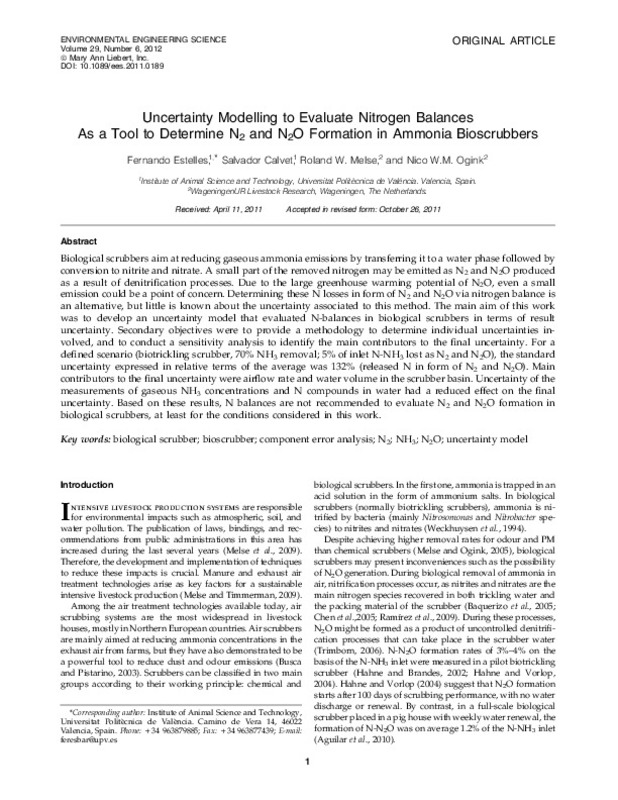JavaScript is disabled for your browser. Some features of this site may not work without it.
Buscar en RiuNet
Listar
Mi cuenta
Estadísticas
Ayuda RiuNet
Admin. UPV
Uncertainty Modelling to Evaluate Nitrogen Balances As a Tool to Determine N2 and N2O Formation in Ammonia Bioscrubbers
Mostrar el registro sencillo del ítem
Ficheros en el ítem
| dc.contributor.author | Estellés Barber, Fernando
|
es_ES |
| dc.contributor.author | Calvet Sanz, Salvador
|
es_ES |
| dc.contributor.author | Melse, Roland W.
|
es_ES |
| dc.contributor.author | Ogink, Nico
|
es_ES |
| dc.date.accessioned | 2013-12-03T15:01:43Z | |
| dc.date.available | 2013-12-03T15:01:43Z | |
| dc.date.issued | 2012 | |
| dc.identifier.issn | 1092-8758 | |
| dc.identifier.uri | http://hdl.handle.net/10251/34260 | |
| dc.description.abstract | Biological scrubbers aim at reducing gaseous ammonia emissions by transferring it to a water phase followed by conversion to nitrite and nitrate. A small part of the removed nitrogen may be emitted as N 2 and N 2O produced as a result of denitrification processes. Due to the large greenhouse warming potential of N 2O, even a small emission could be a point of concern. Determining these N losses in form of N 2 and N 2O via nitrogen balance is an alternative, but little is known about the uncertainty associated to this method. The main aim of this work was to develop an uncertainty model that evaluated N-balances in biological scrubbers in terms of result uncertainty. Secondary objectives were to provide a methodology to determine individual uncertainties involved, and to conduct a sensitivity analysis to identify the main contributors to the final uncertainty. For a defined scenario (biotrickling scrubber, 70% NH 3 removal; 5% of inlet N-NH 3 lost as N 2 and N 2O), the standard uncertainty expressed in relative terms of the average was 132% (released N in form of N 2 and N 2O). Main contributors to the final uncertainty were airflow rate and water volume in the scrubber basin. Uncertainty of the measurements of gaseous NH 3 concentrations and N compounds in water had a reduced effect on the final uncertainty. Based on these results, N balances are not recommended to evaluate N 2 and N 2O formation in biological scrubbers, at least for the conditions considered in this work. © Copyright 2012, Mary Ann Liebert, Inc. | es_ES |
| dc.description.sponsorship | The auhors would like to thank the Netherlands Ministry of Economic Affairs, Agriculture and Innovation, and the Netherlands Ministry of Infrastructure and the Environment, for financial support. | en_EN |
| dc.language | Inglés | es_ES |
| dc.publisher | Mary Ann Liebert | es_ES |
| dc.relation.ispartof | Environmental Engineering Science | es_ES |
| dc.rights | Reserva de todos los derechos | es_ES |
| dc.subject | Biological scrubber | es_ES |
| dc.subject | Bioscrubber | es_ES |
| dc.subject | Component error analysis | es_ES |
| dc.subject | N 2 | es_ES |
| dc.subject | N 2O | es_ES |
| dc.subject | NH 3 | es_ES |
| dc.subject | Uncertainty model | es_ES |
| dc.subject | Air flow-rate | es_ES |
| dc.subject | Bioscrubbers | es_ES |
| dc.subject | Biotrickling | es_ES |
| dc.subject | Denitrification process | es_ES |
| dc.subject | Gaseous ammonia | es_ES |
| dc.subject | Greenhouse warming | es_ES |
| dc.subject | N balance | es_ES |
| dc.subject | N-compounds | es_ES |
| dc.subject | NH <sub>3</sub> | es_ES |
| dc.subject | Nitrogen balance | es_ES |
| dc.subject | Standard uncertainty | es_ES |
| dc.subject | Uncertainty modelling | es_ES |
| dc.subject | Uncertainty models | es_ES |
| dc.subject | Water phase | es_ES |
| dc.subject | Water volumes | es_ES |
| dc.subject | Biofiltration | es_ES |
| dc.subject | Error analysis | es_ES |
| dc.subject | Nitrogen | es_ES |
| dc.subject | Rating | es_ES |
| dc.subject | Scrubbers | es_ES |
| dc.subject | Uncertainty analysis | es_ES |
| dc.subject | Ammonia | es_ES |
| dc.subject | Nitrate | es_ES |
| dc.subject | Nitrite | es_ES |
| dc.subject | Nitrous oxide | es_ES |
| dc.subject | Airflow | es_ES |
| dc.subject | Article | es_ES |
| dc.subject | Denitrification | es_ES |
| dc.subject | Greenhouse effect | es_ES |
| dc.subject | Scrubber | es_ES |
| dc.subject | Sensitivity analysis | es_ES |
| dc.subject.classification | PRODUCCION ANIMAL | es_ES |
| dc.title | Uncertainty Modelling to Evaluate Nitrogen Balances As a Tool to Determine N2 and N2O Formation in Ammonia Bioscrubbers | es_ES |
| dc.type | Artículo | es_ES |
| dc.identifier.doi | 10.1089/ees.2011.0189 | |
| dc.rights.accessRights | Abierto | es_ES |
| dc.contributor.affiliation | Universitat Politècnica de València. Departamento de Ciencia Animal - Departament de Ciència Animal | es_ES |
| dc.contributor.affiliation | Universitat Politècnica de València. Instituto de Ciencia y Tecnología Animal - Institut de Ciència i Tecnologia Animal | es_ES |
| dc.description.bibliographicCitation | Estellés Barber, F.; Calvet Sanz, S.; Melse, RW.; Ogink, N. (2012). Uncertainty Modelling to Evaluate Nitrogen Balances As a Tool to Determine N2 and N2O Formation in Ammonia Bioscrubbers. Environmental Engineering Science. 29(6):1-6. doi:10.1089/ees.2011.0189 | es_ES |
| dc.description.accrualMethod | S | es_ES |
| dc.relation.publisherversion | http://dx.doi.org/10.1089/ees.2011.0189 | es_ES |
| dc.description.upvformatpinicio | 1 | es_ES |
| dc.description.upvformatpfin | 6 | es_ES |
| dc.type.version | info:eu-repo/semantics/publishedVersion | es_ES |
| dc.description.volume | 29 | es_ES |
| dc.description.issue | 6 | es_ES |
| dc.relation.senia | 222906 | |
| dc.contributor.funder | Ministry of Economic Affairs, Agriculture and Innovation, Holanda | es_ES |
| dc.contributor.funder | Ministry of Infrastructure and the Environment, Holanda | es_ES |










